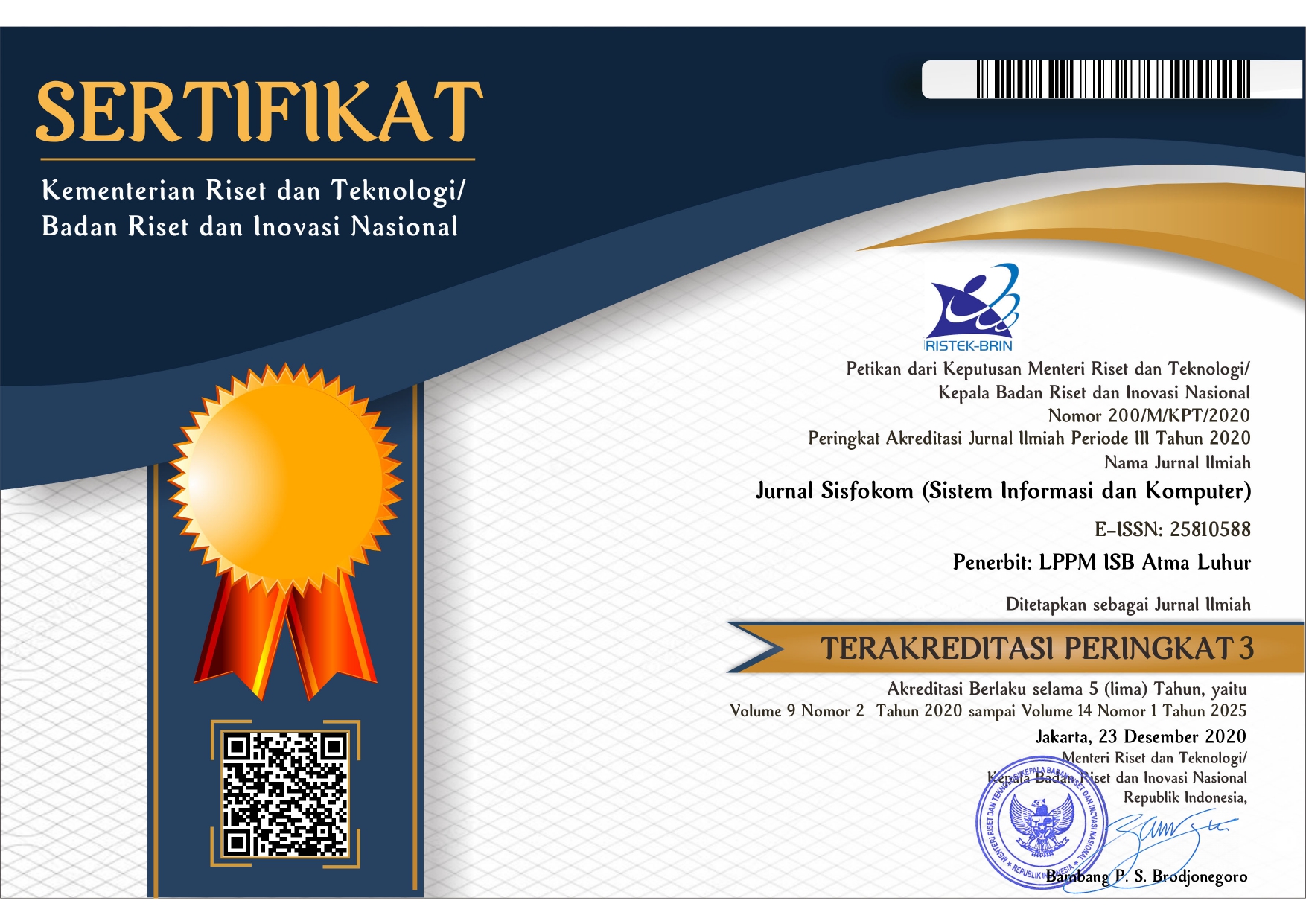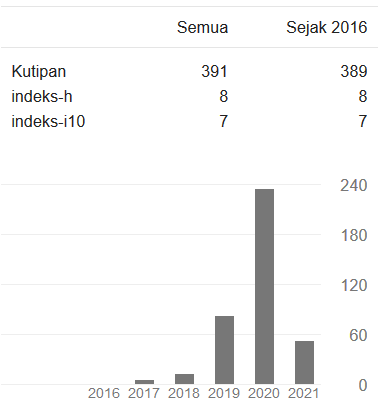User Opinion Mining on the Maxim Application Reviews Using BERT-Base Multilingual Uncased
DOI:
https://doi.org/10.32736/sisfokom.v14i3.2391Keywords:
sentiment analysis, app reviews, BERT, Maxim, Text classificationAbstract
Online transportation applications such as Maxim are increasingly used due to the convenience they offer in ordering services. As usage increases, the number of user reviews also grows, serving as a valuable source of information for evaluating customer satisfaction and service quality. Sentiment analysis of these reviews can help companies understand user perceptions and improve service quality. This study aims to analyze the sentiment of user reviews on the Maxim application using the BERT-Base Multilingual Uncased model. BERT was chosen for its ability to understand sentence context bidirectionally, and it has proven to outperform traditional models such as MultinomialNB and SVM in previous studies, with an accuracy of 75.6%. The dataset used consists of 10,000 user reviews with an imbalanced distribution: 4,000 negative, 2,000 neutral, and 4,000 positive reviews. The data was split into 90% training data (9,000 reviews) and 10% test data (1,000 reviews). From the 9,000 training data, 15% or 1,350 reviews were allocated as validation data, resulting in a final training set of 7,650 reviews. Evaluation results show that BERT is capable of classifying sentiment into three categories positive, neutral, and negative, with an accuracy of 94.7%. The highest F1-score was achieved in the positive class (0.9621), followed by the neutral class (0.9412), and the negative class (0.9246). The confusion matrix shows that most predictions match the actual labels. These findings indicate that BERT is an effective and reliable model for performing sentiment analysis on user reviews of online transportation applications such as Maxim.References
F. Greco, Sentiment analysis and opinion mining. Morgan & Claypool Publishers, 2022. doi: 10.4337/9781800374263.sentiment.analysis.
A. R. Gunawan and R. F. Alfa Aziza, “Sentiment Analysis Using LSTM Algorithm Regarding Grab Application Services in Indonesia,” J. Appl. Informatics Comput., vol. 9, no. 2, pp. 322–332, Mar. 2025, doi: 10.30871/jaic.v9i2.8696.
A. N. Hasanah and B. N. Sari, “ANALISIS SENTIMEN ULASAN PENGGUNA APLIKASI JASA OJEK ONLINE MAXIM PADA GOOGLE PLAY DENGAN METODE NAÏVE BAYES CLASSIFIER,” J. Inform. dan Tek. Elektro Terap., vol. 12, no. 1, Jan. 2024, doi: 10.23960/jitet.v12i1.3628.
K. Adib, M. R. Handayani, W. D. Yuniarti, and K. Umam, “Opini Publik Pasca-Pemilihan Presiden: Eksplorasi Analisis Sentimen Media Sosial X Menggunakan SVM,” SINTECH (Science Inf. Technol. J., vol. 7, no. 2, pp. 80–91, Aug. 2024, doi: 10.31598/sintechjournal.v7i2.1581.
J. U. S. Lazuardi and A. Juarna, “ANALISIS SENTIMEN ULASAN PENGGUNA APLIKASI JOOX PADA ANDROID MENGGUNAKAN METODE BIDIRECTIONAL ENCODER REPRESENTATION FROM TRANSFORMER (BERT),” J. Ilm. Inform. Komput., vol. 28, no. 3, pp. 251–260, Dec. 2023, doi: 10.35760/ik.2023.v28i3.10090.
W. Y. Raden Mas Rizqi Wahyu Panca Kusuma Atmaja, “Analisis Sentimen Customer Review Aplikasi Ruang Guru dengan Metode BERT (Bidirectional Encoder Representations from Transformers),” J. Emerg. Inf. Syst. Bus. Intell., vol. 02, pp. 55–62, 2021.
T. B. B. Wicaksono and R. D. Syah, “IMPLEMENTASI METODE BIDIRECTIONAL ENCODER REPRESENTATIONS FROM TRANSFORMERS UNTUK ANALISIS SENTIMEN TERHADAP ULASAN APLIKASI ACCESS,” J. Ilm. Inform. Komput., vol. 29, no. 3, pp. 254–265, Dec. 2024, doi: 10.35760/ik.2024.v29i3.12514.
B. Prasetyo, Ahmad Yusuf Al-Majid, and Suharjito, “A Comparative Analysis of MultinomialNB, SVM, and BERT on Garuda Indonesia Twitter Sentiment,” PIKSEL Penelit. Ilmu Komput. Sist. Embed. Log., vol. 12, no. 2, pp. 445–454, Sep. 2024, doi: 10.33558/piksel.v12i2.9966.
Y. Wu, Z. Jin, C. Shi, P. Liang, and T. Zhan, “Research on the application of deep learning-based BERT model in sentiment analysis,” Appl. Comput. Eng., vol. 71, no. 1, pp. 14–20, May 2024, doi: 10.54254/2755-2721/71/2024MA.
E. Alzahrani and L. Jololian, “How Different Text-Preprocessing Techniques using the Bert Model Affect the Gender Profiling of Authors,” in Advances in Machine Learning, Academy and Industry Research Collaboration Center (AIRCC), Sep. 2021, pp. 01–08. doi: 10.5121/csit.2021.111501.
J. D. M.-W. C. K. L. K. Toutanova, “BERT: Pre-training of Deep Bidirectional Transformers for Language Understanding,” in Proceedings of NAACL-HLT 2019, pages 4171–4186 Minneapolis, Minnesota, June 2 - June 7, 2019. c 2019 Association for Computational Linguistics, 2019, pp. 4171–4186.
G. Letarte, F. Paradis, P. Giguère, and F. Laviolette, “Importance of Self-Attention for Sentiment Analysis,” in Proceedings of the 2018 EMNLP Workshop BlackboxNLP: Analyzing and Interpreting Neural Networks for NLP, Stroudsburg, PA, USA: Association for Computational Linguistics, 2018, pp. 267–275. doi: 10.18653/v1/W18-5429.
D. E. BIRBA, “A Comparative study of data splitting algorithms for machine learning model selection,” KTH ROYAL INSTITUTE OF TECHNOLOGY, 2020.
T. Pires, E. Schlinger, and D. Garrette, “How Multilingual is Multilingual BERT?,” in Proceedings of the 57th Annual Meeting of the Association for Computational Linguistics, Stroudsburg, PA, USA: Association for Computational Linguistics, 2019, pp. 4996–5001. doi: 10.18653/v1/P19-1493.
X. Liu and C. Wang, “An Empirical Study on Hyperparameter Optimization for Fine-Tuning Pre-trained Language Models,” in Proceedings of the 59th Annual Meeting of the Association for Computational Linguistics and the 11th International Joint Conference on Natural Language Processing (Volume 1: Long Papers), Stroudsburg, PA, USA: Association for Computational Linguistics, 2021, pp. 2286–2300. doi: 10.18653/v1/2021.acl-long.178.
C. Sun, X. Qiu, Y. Xu, and X. Huang, “How to Fine-Tune BERT for Text Classification?,” May 2019, [Online]. Available: http://arxiv.org/abs/1905.05583
Downloads
Published
Issue
Section
License
Copyright (c) 2025 Sindy Eka Safitri, Wenty Dwi Yuniarti, Maya Rini Handayani, Khothibul Umam

This work is licensed under a Creative Commons Attribution 4.0 International License.
The copyright of the article that accepted for publication shall be assigned to Jurnal Sisfokom (Sistem Informasi dan Komputer) and LPPM ISB Atma Luhur as the publisher of the journal. Copyright includes the right to reproduce and deliver the article in all form and media, including reprints, photographs, microfilms, and any other similar reproductions, as well as translations.
Jurnal Sisfokom (Sistem Informasi dan Komputer), LPPM ISB Atma Luhur, and the Editors make every effort to ensure that no wrong or misleading data, opinions or statements be published in the journal. In any way, the contents of the articles and advertisements published in Jurnal Sisfokom (Sistem Informasi dan Komputer) are the sole and exclusive responsibility of their respective authors.
Jurnal Sisfokom (Sistem Informasi dan Komputer) has full publishing rights to the published articles. Authors are allowed to distribute articles that have been published by sharing the link or DOI of the article. Authors are allowed to use their articles for legal purposes deemed necessary without the written permission of the journal with the initial publication notification from the Jurnal Sisfokom (Sistem Informasi dan Komputer).
The Copyright Transfer Form can be downloaded [Copyright Transfer Form Jurnal Sisfokom (Sistem Informasi dan Komputer).
This agreement is to be signed by at least one of the authors who have obtained the assent of the co-author(s). After submission of this agreement signed by the corresponding author, changes of authorship or in the order of the authors listed will not be accepted. The copyright form should be signed originally, and send it to the Editorial in the form of scanned document to sisfokom@atmaluhur.ac.id.









